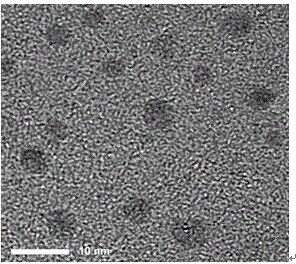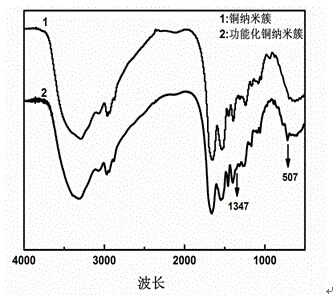Synthesis method for near-infrared fluorescent probe copper nano-cluster and application of synthesis method
A technology of copper nanoclusters and fluorescent probes, which is applied in the field of detection of glycoproteins by copper nanoclusters, can solve the problems of complex detection process, expensive instruments, and long detection time, and achieve simple glycoproteins, uniform size, and simple process Effect
- Summary
- Abstract
- Description
- Claims
- Application Information
AI Technical Summary
Problems solved by technology
Method used
Image
Examples
Embodiment 1
[0046] Synthesis of copper nanoclusters
[0047] Weigh 60 mg of bovine serum albumin and dissolve it in a beaker containing 10 mL of high-purity water. After dissolving, pipette 0.25 mL of CuCl 2 Solution (0.1 mol / L) was added to the reaction system. The solution was in the state of milky white hydrogel, and was stirred for 30 min at room temperature. Pipette 0.5 mL of hydrazine hydrate (pH=8), slowly inject into the reaction vessel, and continue to stir at room temperature for 5 h. The solution was pale yellow, which indicated the formation of copper nanoclusters. The synthesized copper nanoclusters were transferred to the treated dialysis bag for purification, high-purity water was changed every 4 hours, and the dialysis was performed for 24 hours. After the purification was completed, the copper nanoclusters were obtained by vacuum drying at 35 °C, and the fluorescence intensity was detected.
Embodiment 2
[0049] Synthesis of copper nanoclusters
[0050] Weigh 100 mg of bovine serum albumin and dissolve it in a beaker containing 10 mL of high-purity water. After dissolving, pipette 0.25 mL of CuCl 2 Solution (0.1 mol / L) was added to the reaction system. The solution was in the state of milky white hydrogel, and was stirred for 30 min at room temperature. Pipette 0.5 mL of hydrazine hydrate (pH=8), slowly inject into the reaction vessel, and continue to stir at room temperature for 5 h. The solution was pale yellow, which indicated the formation of copper nanoclusters. The synthesized copper nanoclusters were transferred to the treated dialysis bag for purification, high-purity water was changed every 4 hours, and the dialysis was performed for 24 hours. After the purification was completed, the copper nanoclusters were obtained by vacuum drying at 35 °C, and the fluorescence intensity was detected.
Embodiment 3
[0052] Synthesis of copper nanoclusters
[0053] Weigh 160 mg of bovine serum albumin and dissolve it in a beaker containing 10 mL of high-purity water. After dissolving, pipette 0.25 mL of CuCl 2 Solution (0.1 mol / L) was added to the reaction system. The solution was in the state of milky white hydrogel, and was stirred for 30 min at room temperature. Pipette 0.5 mL of hydrazine hydrate (pH=8), slowly inject into the reaction vessel, and continue to stir at room temperature for 5 h. The solution was pale yellow, which indicated the formation of copper nanoclusters. The synthesized copper nanoclusters were transferred to the treated dialysis bag for purification, high-purity water was changed every 4 hours, and the dialysis was performed for 24 hours. After the purification was completed, the copper nanoclusters were obtained by vacuum drying at 35 °C, and the fluorescence intensity was detected. The prepared copper nanoclusters have the highest fluorescence intensity.
PUM
| Property | Measurement | Unit |
|---|---|---|
| diameter | aaaaa | aaaaa |
Abstract
Description
Claims
Application Information
 Login to View More
Login to View More - R&D
- Intellectual Property
- Life Sciences
- Materials
- Tech Scout
- Unparalleled Data Quality
- Higher Quality Content
- 60% Fewer Hallucinations
Browse by: Latest US Patents, China's latest patents, Technical Efficacy Thesaurus, Application Domain, Technology Topic, Popular Technical Reports.
© 2025 PatSnap. All rights reserved.Legal|Privacy policy|Modern Slavery Act Transparency Statement|Sitemap|About US| Contact US: help@patsnap.com



